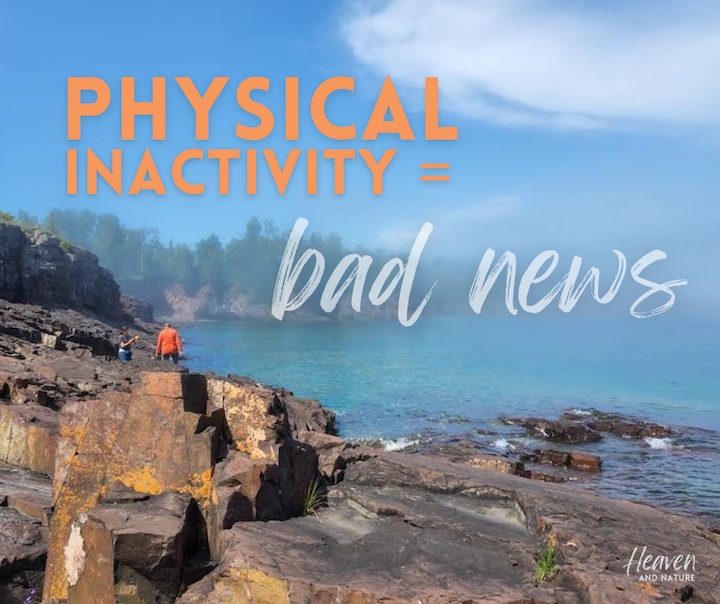Physical inactivity is “the biggest public health problem of the 21st century,” says Dr. Steven Blair. Bigger than smoking? Obesity? Stress? Apparently so.

That’s what Dr. Steven Blair had to say at an annual convention of the American Psychological Association (back in 2009). He’s one of the foremost experts on the relationship of lifestyle to our health.
A quick online search of “dangers of physical inactivity” shows that this isn’t just an American problem. Many are calling it a worldwide pandemic.
An article from the US National Library of Medicine’s Medline Plus website lists several negative results of an inactive lifestyle: tendency to gain weight, loss of muscle strength, loss of bone strength, weaker immune system, poor blood circulation, upset hormonal levels and more inflammation.
More Sedentary in Wealthier Countries
According to a time.com article from 2012, 31% of adults around the world aren’t getting the minimum recommended amount of physical activity.
“The Americas” are the most sedentary of them all (the study included 122 countries).
In America that jumps to 43%…That’s almost half of Americans!
For teens it’s even worse. 4 out of 5 teens (worldwide) don’t get the recommended amount of exercise. That’s 80% of them.
(These are 2012 numbers. Do you think they’re increased or decreased since then?)
Here’s why: We sit so much! At home in front of screens or books…at work at a desk or table…commuting to work in a car, bus or train.
So many things about our modern lifestyle are a blessing—but not all of them!
What’s So Great about Physical Activity?
Being physically active as a lifestyle lowers your risk — in some cases dramatically — of all kinds of diseases and health issues. Here’s a short list to begin with:
- Heart disease
- Stroke
- High blood pressure
- Type 2 diabetes
- Breast cancer
- Colon cancer
- Prostate, lung and endometrial cancers were less conclusive, but several studies have shown an inverse correlation between physical activity and these types of cancers
- Osteoporosis (and bone fractures)
- Obesity
- Depression
- Dementia and Alzheimer’s
(“Physical Inactivity: Associated Diseases and Disorders” by Joseph A. Knight M.D.)
On the flip side, combine a sedentary lifestyle with other major health problems like smoking, obesity and high stress, you multiply your chances of inviting some of those diseases into your life.

As We get Older…
Some of the diseases and conditions we associate with aging are really diseases and conditions that result from a lifetime of physical inactivity.
Here’s a quote (of a quote) from an article on ScienceDaily.com:
“Regular physical activity has also been associated with greater longevity as well as reduced risk of physical disability and dependence, the most important health outcome, even more than death, for most older people…”
The good news? We can do something about it.
What’s the Recommended Amount of Exercise?
A minimum of 150 minutes a week of moderate exercise is what I hear and read the most. More vigorous intensity (i.e., running instead of walking) and even 75 minutes a week will make a difference.
That’s 30 minutes five days a week. And unless you’re working to build your endurance (for something like a race), the 30 minutes don’t need to be all at once. Three 10-minute sessions apparently give you the same health benefits as a 30-minute session.
How doable is that? Very doable.
Even better? The Institute of Medicine recommends one hour of activity daily, including both aerobic (exercises that make you breath hard) and resistance (strength training).
That’s especially true if you want it to make a difference in weight management.
Don’t Sit the Other 23 Hours of the Day!
This article from 2015 says 30-60 minutes of exercise a day—while great—shouldn’t give us a pass to sit the other 23 hours of the day, though:
“A new piece of research, distilling the conclusions of 47 past studies, has found an hour of exercise a day is not enough to offset the negative effects of sitting for the remaining 23 hours.”
I’ve read and heard that from others over the past few years, too. So I’ve personally tried to stick to a habit of sitting for no more than 30 minutes before I get up to walk around.
We’ve all heard ways we can add activity into our day. It’s easy really:
- Take the stairs instead of the elevator…
- Don’t look for the closest parking spot—find one that forces you to walk…
- When you talk on the phone, walk around instead of sit…
I work from home so I save home chores to do every 30 minutes or so. Unload the dishwasher, change out the laundry, vacuum, dust, whatever.
I also started “counting steps” most days. Lots of expert-type-people seem to agree that 10,000 steps a day is a great goal, especially when spread throughout the day.
Trying to hit that goal is one motivator for me to get out and walk most days. It’s hard for me to hit the 10,000-step mark without a 2-3 mile walk.
How will You Take Action?
We’re the most educated and informed people in the history of this planet. But that hasn’t stopped us from also being the most sedentary, even though we know it’s terrible for us.

But…it’s not too late to step it up! If you don’t already have a lifestyle of regular physical activity, let this spur you on to start today.
This isn’t about being buff and ready to run 10 marathons this year. It’s about a quality of life that makes it possible for us to keep working…keep up with our children and grandchildren…continue on in whatever ministry we’re called to—well into old age.
Physical activity isn’t the only thing that matters, of course. Diet is hugely important. So is our thought life and how we handle stress.
God gave us just one body to live in while we’re here on this earth. I don’t want to be responsible for not being able to fulfill all of what God’s planned for me to do because of preventable health issues. I don’t think you do either.
One of my favorite authors is John Maxwell. In his book Today Matters, he writes:
“The way you live today impacts your tomorrow…Hoping for a good future without investing in today is like a farmer waiting for a crop without ever planting any seed.”
So let’s plant good seeds for a healthy future!
(I first published this article in June of 2015, and have updated it to reflect more recent research and links.)
Here’s more…
- The Many Health Benefits of Walking
- How to Raise Our Girls to Love the Outdoors
- A Life Well-Lived: In Honor of My Outdoors Dad
- Don’t Miss the Dream Lake Hike When You Visit Rocky - June 26, 2025
- Ride a Bike for the Best Mackinac Island Experience - June 12, 2025
- The Light of the Lord Shines in the Darkness - May 12, 2025
